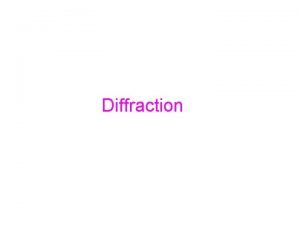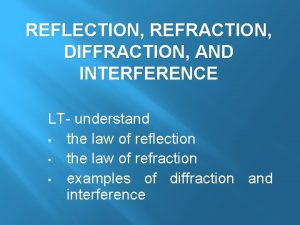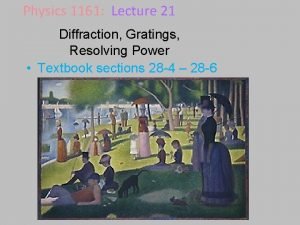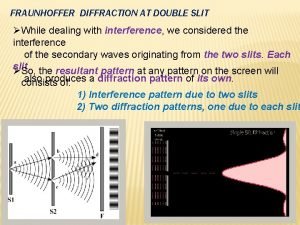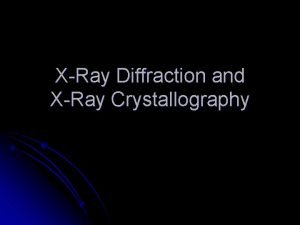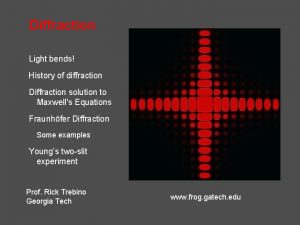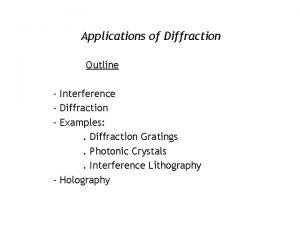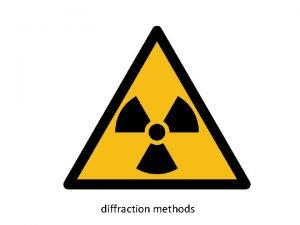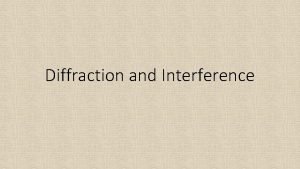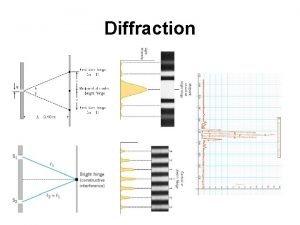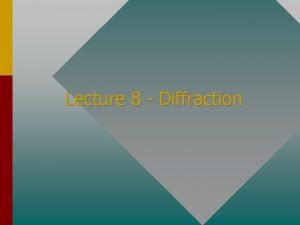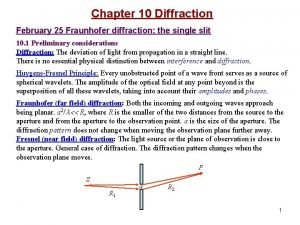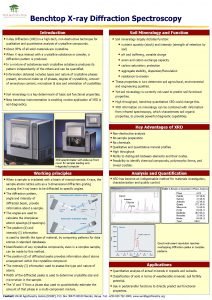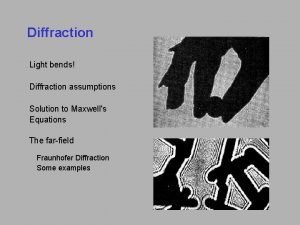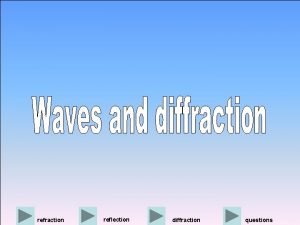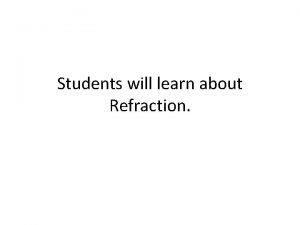Understanding Diffraction Part of q Understanding Diffraction Using















- Slides: 15

Understanding Diffraction Part of q Understanding Diffraction. (Using some illustrative but ‘crude’ analogies!). q Understanding Crystallite size broadening. (The basis of ‘Scherer’s formula’). MATERIALS SCIENCE & A Learner’s Guide ENGINEERING AN INTRODUCTORY E-BOOK Anandh Subramaniam & Kantesh Balani Materials Science and Engineering (MSE) Indian Institute of Technology, Kanpur- 208016 Email: anandh@iitk. ac. in, URL: home. iitk. ac. in/~anandh http: //home. iitk. ac. in/~anandh/E-book. htm Analogies are very brittle do not stretch them!

Diffraction q Diffraction sometimes seems a ‘mysterious’ phenomenon, which is difficult to understand. q We have noted that electromagnetic waves (light, X-rays etc. ), water waves (i. e. elastic waves in a solid or fluid), matter waves (electrons, neutrons) etc. can be diffracted. In fact it is best to start understading diffraction using water waves with a single slit. q Diffraction can be thought of as a special case of constructive and destructive interference (a case where there is a large number of scatterers*). What are these scatterers? A: Any entity which impedes (partially and ‘redirects’) the path of wave can be conceived as a scatterer. Scatterers has to be understood in conjunction with the wave being considered [i. e. an entity may be a scatter for one kind of waves, but not for another (e. g. an array of atoms is a scatterer for Xrays, but it is not a scatterer for water waves)]. In a periodic array they can be entities of the motif [i. e. a geometrical entity (atoms, ions, blocks of wood), physical property (e. g. aligned spins) or a combination of both]. q Experiments have been conducted where ‘matter waves’ have been diffracted from a crystal made of electromagnetic radiation (waves)! (Atoms diffracted from a Laser lattice). q We will use some ‘crude’ analogies and some ‘schematic cartoons’ to get a hang of this phenomenon → these should not be taken literally. * Usually in a periodic array. ** Though other simple configurations may be envisaged.

What is the minimum I need to see diffraction/interference? § The bare minimum is one edge*. Two edges forming a single slit is better to get a better picture. § An experiment with two slits (e. g Young’s double slit experiment), is very fascinating in many respects. § The phenomenon of diffraction is often stated as bending of waves around edges. § When a wave encounters a slit, this aspect leads to intensity in the geometrical shadow region of the slit (i. e. the interference pattern observed on the screen consists of peaks and valleys, with some intensity pattern in the geometrical shadow region as well). § One method to understand this is the Huygens wavelet construction. (Wherein, each point in the unobstructed wave-front is considered as a source of wavelets. These wavelets propagate to the screen and lead to a interference pattern). * Which blocks part of the wave.

Let us start by throwing some balls on a wide slit. Geometrical shadow region of zero intensity ‘Intensity*’ 1 on ‘screen’ Screen Obstacle 0 Near the edges the intensity will be different (but we will ignore this for now) If we shine ‘incoherent light’ we will get a similar ‘intensity’ distribution. The balls in the gap pass ‘right through in a straight line’ (well most of the ones!), while the ones blocked by the obstruction reflect back (reflection not shown). * Intensity ~ no. of balls/area/time Warning: these cartoons do not depict diffraction- they are a way to start visualizing the issues!

More cartoons on network What about the ones hitting the edge? Obstacle 0 Altered ‘intensity’ pattern Screen Intensity on screen (this is not one peak but a broad diffuse one as the way the balls hit the barrier edge will send them off in different angles) 1 Centre of mass near edge. Glancing angle collision. This is not what happens in diffraction. This is to tell you that ‘watch out for sharp corners’!!

Region of geometrical shadow What if the slit width is of the order of the ‘ball size’? 0 There is ‘intensity’ in the ‘geometrical shadow’ region as well! q So we have seen that even with macroscopic balls it is possible to get ‘intensity’ in the region of the geometrical shadow. q For this effect to be prominent we have noticed that the slit width has to be of the order of the ‘size’ of the ball.

Another ‘crude’ analogy to understand diffraction § Consider a series of speed breakers (bumps) on the road (say sinusoidal bumps of amplitude ‘A’ = /2). Let a vehicle (with tire diameter ‘d’) arrive at a velocity ‘v’. § Three cases can be considered here: (i) d >> (large dump trucks, with tire diameter twice the height of a human) , (ii) d ~ (a scooter tire), (iii) d >> (a toy car). § In the first and last scenarios the vehicle does not feel any jerk. In the case of the scooter tire, we feel a lot of jerk and ‘thrown about’ a lot in the z-direction. § This analogy helps us visualize the statement: ‘if the wavelength is of the order of the scatter spacing then we are in the diffraction dominated regime’.

Understanding constructive and destructive interference q In these set of slides we will try to visualize how constructive and destructive interference take place (using the Bragg’s view of diffraction as ‘reflection’ from a set of planes). q It is easy to ‘see’ as to how constructive interference takes place; however, it is not that easy to see how ‘rays’ of the Bragg angle ‘go missing’.

(press page down button to see the successive graphics) Constructive Interference Here we see waves scattered from two successive planes interfering constructively. (A phase shift of occurs at ‘Y’ on scattering) Ray-1 Ray-2 Plane-1 d(hkl) Plane-2 § Note the phase difference of introduced during the scattering by the atom at ‘Y’. § The extra path length travelled by Ray-2 (as compared to Ray-1) is: /2 + /2 = . § In general for constuctive interference the path difference has to be an integral multiple of : 1 , 2 , 3 , 4 , . . .

The ‘rays’ ray-1 and ray-2 arrive in phase in the X-B plane.

Assuming that path difference of gives constructive interference: Similar to the path difference of , path difference of 2 , 3 … n also constructively interfere. Path difference between Ray-1 & Ray 2 1 st order reflection All Constructively interfere 2 nd order reflection 3 rd order reflection Also to be noted is the fact that if the path difference between Ray-1 and Ray-2 is then the path difference between Ray-1 and Ray-3 is 2 and Ray-1 and Ray-4 is 3 etc. Going across planes

Destructive Interference Exact destructive interference (between two planes, with path difference of /2) is easy to visualize. The angle is not Bragg’s angle (let us call it d ).

Destructive Interference At a different angle ’ the waves scattered from two successive planes interfere (nearly) destructively Warning: this is a schematic

q In the previous example considered ’ was ‘far away’ (at a larger angular separation) from Bragg and it was easy to see the (partial) destructive interference. q In other words for incidence angle of d (couple of examples before) the phase difference of is accrued just by traversing one ‘d’. q If the angle is just away from the Bragg angle ( Bragg), then one will have to go deep into the crystal (many ‘d’) to find a plane (belonging to the same parallel set) which will scatter out of phase with this ray (phase difference of ) and hence cause destructive interference. q In the example below we consider a path difference of /10 between the first and the second plane (hence, we will have to travel 5 planes into the crystal to get a path difference of /2).

q If such a plane (as mentioned in the page before) which scatters out of phase with a off Bragg angle ray is absent (due to finiteness of the crystal) then the ray will not be cancelled and diffraction would be observed just off Bragg angles too line broadening! (i. e. the diffraction peak is not sharp like a -peak in the intensity versus angle plot) q Line broadening can be used to calculate crystallite size (grain size). q This is one source of line broadening. Other sources include: residual strain, instrumental effects, stacking faults etc.
 Diffraction ocean waves
Diffraction ocean waves Addition symbol
Addition symbol Unit ratio definition
Unit ratio definition Part part whole
Part part whole Technical description examples
Technical description examples Parts
Parts The phase of the moon you see depends on ______.
The phase of the moon you see depends on ______. 미니탭 gage r&r 해석
미니탭 gage r&r 해석 Special product formula
Special product formula Thin film formula
Thin film formula Reflection refraction diffraction interference
Reflection refraction diffraction interference Refraction vs diffraction
Refraction vs diffraction Multiple slits diffraction
Multiple slits diffraction Magnets for neutron diffraction
Magnets for neutron diffraction Missing order in diffraction
Missing order in diffraction Dispersive power of a grating
Dispersive power of a grating
